How to Invest in Farmland with AcreTrader
Table of contents

There’s an old slang term that emerged around World War II, and you still hear it today: “He bought the farm.” It referred to when a service member died. The military would pay out a death beneficiary to the family. The payout would perhaps fulfill the dream of buying a little plot of land somewhere on which to raise the kids and crops. That dream has been on a steady decline, as there are only about two million farms today, down from nearly seven million at peak ag in 1935, according to the USDA.
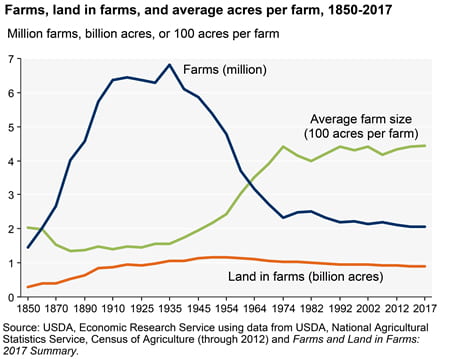
However, until we figure out how to scale synthetic foods made from yeast, farms aren’t going anywhere. People have to eat, and we know there will be 10 billion mouths to feed by mid-century. In fact, one would think that between shrinking acreage and failing soil health, a well-run and productive farm is becoming more rare and valuable over time. And, unless you’re an actual farmer (more than half lose money every year), there’s a way to make money without mucking manure. Let’s talk about how to invest in farmland with AcreTrader, an ag real estate investment platform.
Why Invest in Farmland?
Regular readers may recall that we first wrote about why farmland investing makes sense just a couple of months ago. In that piece, we talked in length about the value of diversifying your portfolio, especially striking a balance between risk and reward among your investments. That seems more important than ever these days, given the diversification of reality itself. How else to explain the stock market, where investors have apparently used the Hot Tub Time Machine to warp back a few years to the middle of the longest bull run in history. One way to ride out such volatility is with a dividend-growth investing strategy where you build a portfolio run on the world’s most reliable dividend-paying companies. Another way is by investing in alternative asset classes which aren’t correlated to popular asset classes like stocks and bonds.
One interesting alternative asset is farmland investing. If you’re looking for passive income, a farmland investment can provide bond-like income streams from contractual lease obligations, some with fixed yearly increases to help offset inflation. When it comes time to exit, land value appreciation can provide capital gains similar to the capital appreciation of a stock.
In terms of return on investment, farmland pretty much plows over most other asset classes in the long term, as you can see in the chart below.
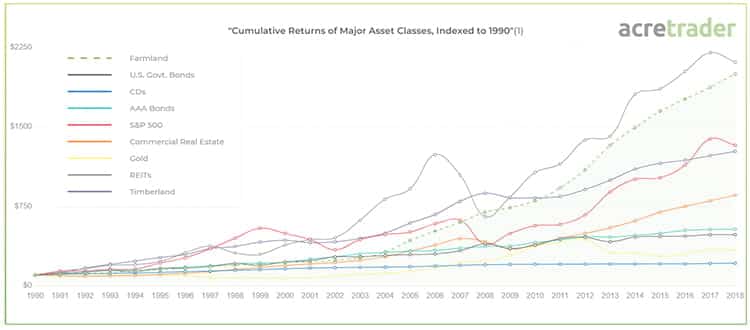
This next spiffy chart shows how the investment in the operation and land is also relatively low risk compared to other types of assets.
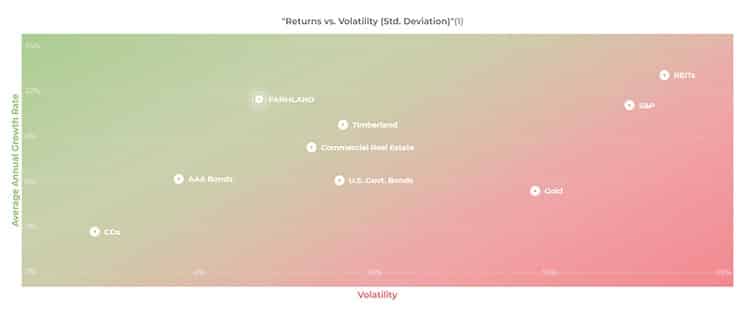
In addition, farmland investing offers an escape from the gravitational ebb and flow of the stock market. In other words, farmland returns also move independently of whichever tweet Elon Musk sent out that morning. Historical data show farmland has no relationship with stock market returns:
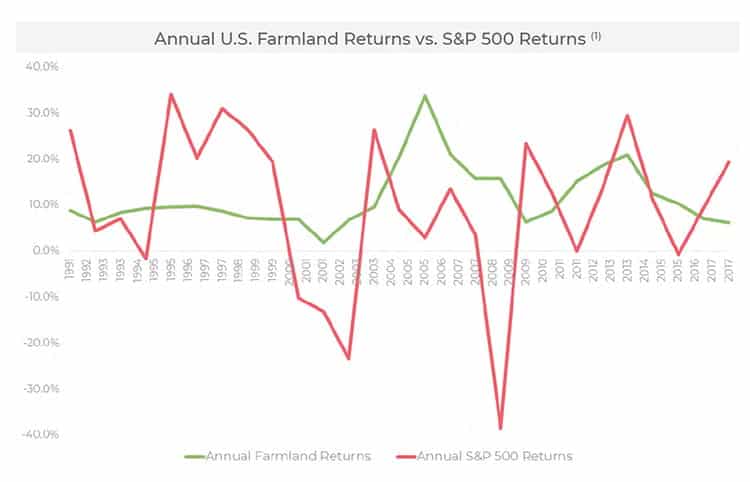
If the idea of investing in farmland makes you happier than a pig in mud, let’s talk about how to do it.
How to Invest in Farmland with AcreTrader
In our previous piece, we profiled FarmTogether, a San Francisco startup that allows accredited investors to get a little piece of the action by purchasing shares in an LLC. You become a fractional owner of the farmland and are entitled to returns from its operation and eventual sale. The business model for AcreTrader out of Fayetteville, Arkansas, is pretty similar.
About Acretrader
Founded just two years ago, the agprop startup has taken in $8.2 million, including a $5 million Seed round earlier this year. The chief farmer-in-the-dell is a guy named Carter Malloy, who reportedly grew up in an Arkansas farming family and later went on to work as a managing director with Stephens Inc., a large private investment bank. Presumably, he knows how to find the needle in the haystack when it comes to investing in farmland.
Update 01/12/2022: AcreTrader has raised $40 million in Series B funding to support growth of their platform, hire more technology, finance, and agriculture employees, and work with more farmers and landowners to build a larger market. This brings the company’s total funding to more than $57 million to date.
Like FarmTogether, AcreTrader claims it’s very particular when it comes to the properties that it invests in, selecting less than 1% of the parcels it reviews. Each entity is divided into shares equivalent to 1/10 of an acre. So, if you buy 20 shares, your ownership represents the equivalent of two acres of land and the associated distributions. Rent is collected in advance of the planting season, so the risk is really on the sharecropper farmer. AcreTrader gets its cut by charging a flat annual administration fee of 0.75% of the overall farm value, which is typically deducted from the income of the farm.
Investors realize two revenue streams. One is from excess annual income based on the lease, which is typically 3%-5%. The second is from the annual appreciation of the property itself, which is conservatively pegged at 7%-9%. The latter payout comes after a certain time horizon, typically three to five years, though some yield-focused properties may have hold times of five to 10 years. The company was expected to open up a secondary market this year for investors who want to bail early.
It’s sort of like temporarily owning a timeshare that you can’t visit but actually makes you money rather than costs you a crummy two-week vacation in the Arizona desert.
Examples of AcreTrader Properties
Let’s see how this works with real-world examples. Fortunately, AcreTrader just this week opened up two new properties for farmland investors. One farm is located in Pulaski County, Georgia and grows Southern staples like cotton and peanuts. Up to the Midwest, we find Iroquois County, Illinois, which produces the staples of the processed American diet – corn and soybeans. Let’s look more closely at Tenmile Peanut Farm.
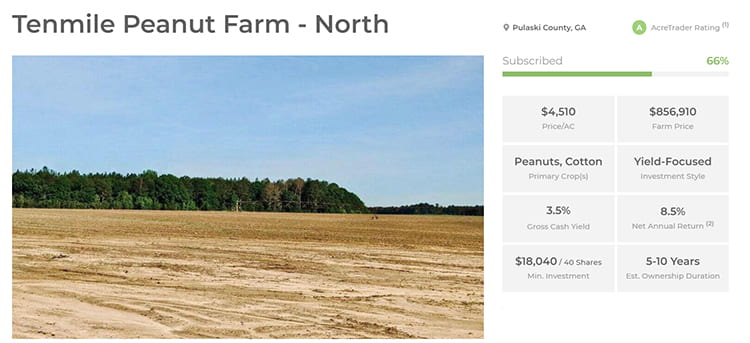
As you can see, it will cost you $18,040 to get a piece of the peanut farm. AcreTrader provides quite a bit of color in its descriptions, including potential future revenue streams. For example, this farm is expected to grow melons every fourth year, which may boost lease income by 10%-20% – numbers not included in financial projections. The 190-acre property also includes 25 acres of woods that could be cleared for crop production. Timber obviously offers additional market value – also unaccounted for in financial projections.
The company also has its own rating system for comparing farmland assets. The scoring is based on 12 objective criteria, such as flooding issues, debt, and local real estate conditions. Here’s a partial look at the evaluation form:
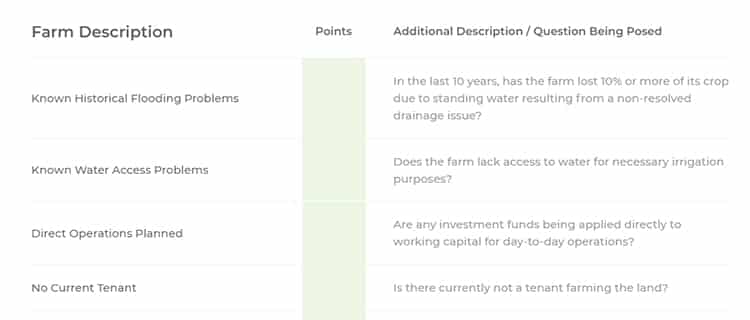
Even though both properties just went online, they’re already more than 50% subscribed.
Conclusion
In fact, AcreTrader has already closed on more than a dozen deals and claims more than 10,000 subscribers. While we usually avoid canned speeches from press releases, we did find this partial quote interesting from Matt Tarver, partner at RZC Investments, which led the Seed round: “… after reviewing the market opportunity and positive customer feedback, it became clear that the company is poised to modernize land investing.” Investing in farmland certainly seems like a safer bet than indoor farming wonderlands that keep microgreens on a Millennial’s avocado toast. Agprop startups like AcreTrader offer to grow a different kind of green.
Sign up to our newsletter to get more of our great research delivered straight to your inbox!
Nanalyze Weekly includes useful insights written by our team of underpaid MBAs, research on new disruptive technology stocks flying under the radar, and summaries of our recent research. Always 100% free.















